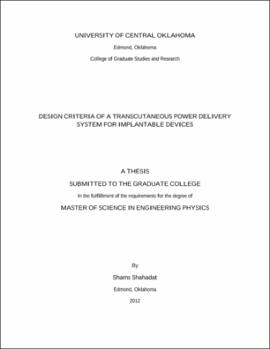| dc.contributor.advisor | Jassemnejad, Baha | |
| dc.contributor.author | Shahadat, Shams | |
| dc.date.accessioned | 2020-05-26T20:40:31Z | |
| dc.date.available | 2020-05-26T20:40:31Z | |
| dc.date.issued | 2012 | |
| dc.identifier.other | (AlmaMMSId)9979368685202196 | |
| dc.identifier.uri | https://hdl.handle.net/11244/324746 | |
| dc.description.abstract | Implantable cardiac assist devices such as artificial hearts and blood pumps are a rapidly growing therapy used for treating moderate to severe congestive heart failure. While current treatments offer improved heart failure survival and increased patient functionality with enhanced quality of life, powering these devices are still constraining. In practice, percutaneous cables passing through skin are used for power and control data transmission requiring patients to maintain a sterile dressing on the skin cable-exit site. This contact site limits patient movement as it is vulnerable to wound infection due to trauma and poor healing. As a result, a sterile dressing has to be maintained and nursed regularly for treating the wound. Complications from the exit site infections are a leading cause of death in long-term support with these devices. Wireless power and control transmission systems have been studied and developed over years in order to avoid percutaneous cables while supplying power efficiently to the implanted device. These power systems, commonly named Transcutaneous Energy Transfer (TET) systems, enable power transmission across the skin without direct electrical connectivity to the power source. TET systems use time-varying electromagnetic induction produced by a primary coil that is usually placed near skin outside the body. The induced voltage in an implanted secondary coil is then rectified and regulated to transfer energy to an implanted rechargeable battery in order to power the biomedical load device. Efficient and optimum energy transfer using such transcutaneous methods is more complex for mobile patients due to coupling discrepancies caused by variations in the alignment of the coil. The research studies equivalent maximum power transfer topologies for evaluating voltage gain and coupling link efficiency of TET system. Also, this research adds to previous efforts by generalizing different scenarios of misalignments of different coil size that affects the coupling link. As a whole, this study of geometric coil misalignments reconsiders potential anatomic location for coil placement to optimize TET systems performance in anticipated environment for efficient and safe operation.--Abstract. | |
| dc.rights | All rights reserved by the author, who has granted UCO Chambers Library the non-exclusive right to share this material in its online repositories. Contact UCO Chambers Library's Digital Initiatives Working Group at diwg@uco.edu for the permission policy on the use, reproduction or distribution of this material. | |
| dc.subject.lcsh | Heart, Artificial | |
| dc.subject.lcsh | Cardiovascular instruments, Implanted | |
| dc.title | Design criteria of a transcutaneous power delivery system for implantable devices. | |
| dc.type | Academic theses | |
| dc.contributor.committeeMember | Abu-Abed, Alaeddin | |
| dc.contributor.committeeMember | Jiang, Yuhao | |
| dc.thesis.degree | M.S., Engineering Physics | |
| dc.identifier.oclc | (OCoLC)ocn857852505 | |
| uco.group | UCO - Graduate Works and Theses::UCO - Theses | |
| thesis.degree.grantor | Jackson College of Graduate Studies | |
